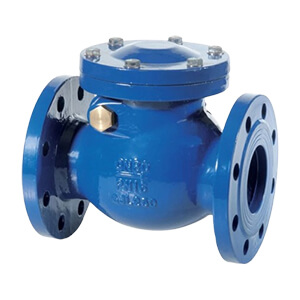1. Backflow Issues
Problem: Backflow is one of the primary functions that a check valve is designed to prevent. When the valve fails to close properly, it allows fluid to flow backward, potentially causing system contamination, pressure damage, or equipment failure. Causes:Over time, the valve's disc or ball can wear down, preventing it from forming a proper seal.
Particles or foreign objects lodged inside the valve may prevent the disc or ball from fully seating.
If the check valve is not installed correctly or oriented in the wrong direction, it may not function properly.
Solution:Regularly inspect and clean the valve, removing debris or buildup.
Replace damaged sealing components, such as the disc or ball, and ensure they are made of high-quality, durable materials.
Always follow the manufacturer’s installation instructions to ensure the valve is correctly placed within the system.
2. Valve Sticking or Binding
Problem: If the check valve sticks or binds, it can fail to open or close properly, which could result in a complete stoppage of flow or inefficient flow regulation.
Causes:Dirt, sludge, or other particles can accumulate inside the valve and prevent it from operating smoothly.
Over time, corrosion or wear can cause the valve parts, like the disc or ball, to become stuck.
Thick fluids can cause resistance to movement, making it difficult for the valve to operate.
Solution:Clean the valve regularly to ensure there are no obstructions blocking the internal components.
For systems with corrosive fluids, use check valves made from corrosion-resistant materials.
In systems with high-viscosity fluids, consider using check valves designed to handle thicker liquids or adjusting the valve size to reduce resistance.
3. Chattering or Vibrations
Problem: A common issue in check valves, particularly in high-flow or high-velocity systems, is chattering or vibrating. This can cause unnecessary wear on the valve and other components of the system.
Causes:High-flow conditions can cause the valve disc or ball to move erratically, resulting in vibrations and pressure fluctuations.
If the valve is too small for the required flow, it may be prone to oscillating and chattering.
Certain check valve designs, such as swing check valves, are more prone to chattering, especially in systems with fluctuating pressures.
Solution:Ensure the valve is correctly sized for the system’s flow conditions. Oversized or undersized valves can lead to instability.
Install tilting disc check valves or silent check valves, which are designed to minimize chattering.
Consider installing a pressure-reducing valve or a surge tank to help regulate pressure spikes and reduce flow instability.
4. Leakage at the Valve Seat
Problem: Leakage around the valve seat can occur even when the valve is supposedly in the closed position, allowing fluids to bypass the valve.
Causes: With time, the valve seat may degrade, resulting in a poor seal and leakage.
If the valve seat is misaligned, it may not form a perfect seal with the valve disc, allowing leakage.
If the valve is made from substandard materials, it may wear down more quickly, leading to seat damage.
Solution:Inspect the valve seat periodically for signs of wear or damage, and replace it when necessary.
Ensure that the valve is properly aligned during installation to maintain a good seal.
Choose check valves made from high-quality, durable materials that can withstand the conditions of the system.
5. Pressure Drop Across the Valve
Problem: A significant pressure drop across the check valve can reduce system efficiency, affecting flow and possibly causing cavitation or other issues downstream.
Causes:Check valves with small openings or designs that cause high resistance can result in a large pressure drop.
Sediment buildup inside the valve can restrict flow and cause pressure loss.
A poorly installed valve, such as one that’s too large or too small for the system, can cause excessive pressure loss.
Solution:Choose a check valve with a flow design that minimizes resistance, such as a tilting disc or ball check valve.
Install strainers or filters upstream to prevent debris and sediment from entering the valve.
Ensure the valve is properly sized and installed according to system specifications to minimize unnecessary pressure loss.
6. Water Hammer or Shock
Problem: Water hammer occurs when a check valve closes too quickly, causing a sudden pressure surge in the pipeline. This can result in damage to the valve, pipes, and equipment.
Causes:If the check valve closes too abruptly, it can create a pressure wave that propagates through the system.
Systems with fast-flowing fluids are more susceptible to water hammer.
Solution:Use check valves with slow-closing mechanisms, such as spring-loaded check valves or cushion valves, to prevent rapid closure.
Implement water hammer arrestors or surge tanks to dampen pressure spikes.
Consider adjusting flow rates or installing pressure relief valves to reduce the risk of shock.

.png)
 en |
en |















